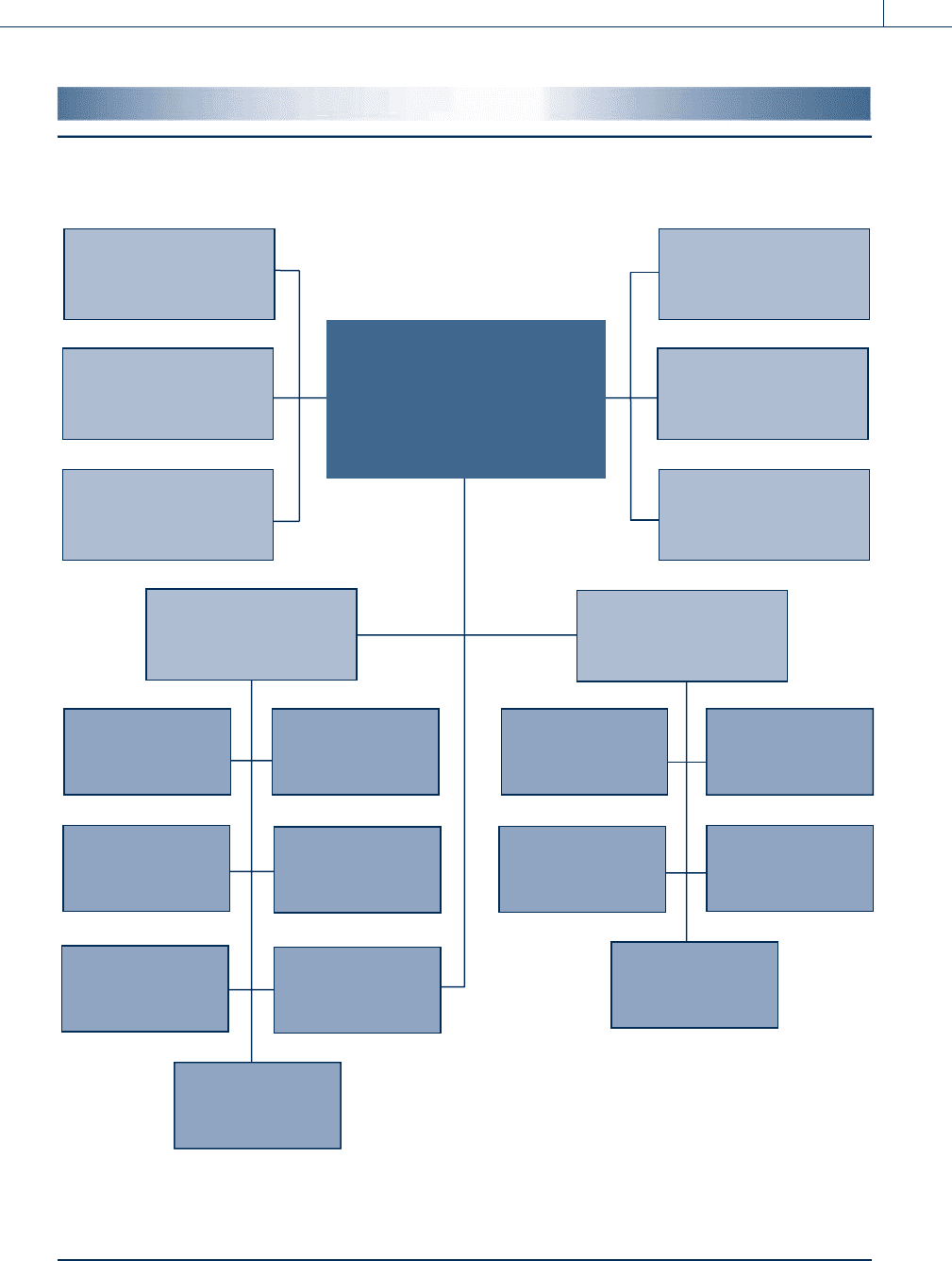Whittenburg Gerald E., Altus-Buller Martha. Income Tax Fundamentals
Подождите немного. Документ загружается.


Student Name
Class/Section
Date
KEY NUMBER TAX RETURN SUMMARY
Chapter 11
Comprehensive Problem 1
Total Income (Line 11) ________________
Dividends Received Deduction (Line 29c) ________________
Taxable Income (Line 30) ________________
Tax Liability (Line 31) ________________
Tax Overpaid (Line 35) ________________
Comprehensive Problem 2
Cost of Goods Sold (Line 2) ________________
Total Income (Line 6) ________________
Ordinary Business Income (Line 21) ________________
Tax Liability (Line 25) ________________
Qualified Dividends (Schedule K, Line 5b) ________________
Questions and Problems 11-47
Copyright 2010 Cengage Learning. All Rights Reserved. May not be copied, scanned, or duplicated, in whole or in part. Due to electronic rights, some third party content may be suppressed from the eBook and/or eChapter(s).
Editorial review has deemed that any suppressed content does not materially affect the overall learning experience. Cengage Learning reserves the right to remove additional content at any time if subsequent rights restrictions require it.

c
Yuri Arcurs/Shutterstock
Copyright 2010 Cengage Learning. All Rights Reserved. May not be copied, scanned, or duplicated, in whole or in part. Due to electronic rights, some third party content may be suppressed from the eBook and/or eChapter(s).
Editorial review has deemed that any suppressed content does not materially affect the overall learning experience. Cengage Learning reserves the right to remove additional content at any time if subsequent rights restrictions require it.

Chapter 12
Tax Administration
and Tax Planning
LEARNING OBJECTIVES
.............................................. .........................
After completing this chapter, you should be able to:
LO 12.1 Identify the organizational structure of the IRS.
LO 12.2 Understand the IRS audit process.
LO 12.3 Define the common penalties for taxpayers and tax
preparers and be able to apply them to specific situations.
LO 12.4 Apply the general rule for the statute of limitations on tax
returns and the important exceptions to the general rule.
LO 12.5 Describe the rules that apply to tax practitioners and the
Taxpayer Bill of Rights.
LO 12.6 Understand the basic concepts of tax planning.
Overview
Knowing how the IRS operates, and how and why the IRS audits certain returns, is
extremely important to tax practitioners. This chapter covers these topics as well as tax
penalties that appl y to taxpayers and tax preparers, the statue of limitations on tax liabil-
ities, and rules applicable to tax practitioners (i.e., Circular 230). The taxpayer ‘‘Bill of
Rights,’’ also covered in this chapter, provides taxpayers with significant rights when deal-
ing with the IRS, such as the ability to record an IRS interview.
Arranging one’s financial affairs in order to minimize tax liability is referred to as tax
planning. This chapter includes a discussion of basic tax-planning techniques that may be
used by individual taxpayers. This final chapter is intended to give an appreciation for
the process of dealing with the IRS and several of the many issues involved in conducting
a tax practice.
12-1
Copyright 2010 Cengage Learning. All Rights Reserved. May not be copied, scanned, or duplicated, in whole or in part. Due to electronic rights, some third party content may be suppressed from the eBook and/or eChapter(s).
Editorial review has deemed that any suppressed content does not materially affect the overall learning experience. Cengage Learning reserves the right to remove additional content at any time if subsequent rights restrictions require it.

SECTION 12.1
THE INTERNAL REVENUE SERVICE
The tax laws of the United States are administered by the Internal Revenue Service (IRS).
In administering the tax law, the IRS has the responsibility for determining, assessing, and
collecting internal revenue taxes and enforcing other provisions of the tax law. The IRS is a
division of the Treasury Department.
The IRS organization currently consists of a national office in Washington, D.C., ten
service centers, and various oper ational offices throughout the USA. The national office
is the headquarters of the commissioner of internal revenue and various deputy and asso-
ciate commissioners. The commissioner of internal revenue is appointed by the president
of the United States with the advice and consent of the Senate. The responsibilities of the
commissioner are to establish policy, to supervise the activities of the organization, and to
act in an advisory capacity to the Treasury Department on legislative matters. In addition,
the commissioner is responsible for the collection of income tax, auditing of tax returns,
intelligence operations, and appellate procedures.
Service Centers
In addition to the various operational offices discu ssed below, the IRS currently maintains
ten service centers. At these service centers, the IRS computers process the information
from tax documents such as tax returns, payroll tax forms, Form 1099s, and withholding
forms. Service centers are located in the following cities:
Atlanta, GA Fresno, CA
Austin, TX Kansas City, MO
Andover, MA Memphis, TN
Holtsville, NY Ogden, UT
Cincinnati, OH Philadelphia, PA
The IRS also maintains a national computer center in Martinsburg, West Virginia,
where information from various service centers is matched with records from other service
centers. This cross-matching of records helps to assure that taxpayers report all their
income and do not file multiple refund claims.
The 1998 IRS Restructuring Act
1
The Service wa s completely reorganized under the 1998 IRS Restructuring Act (RRA 98)
which resulted in the new structure as shown in Figure 12. 1. During the years follow ing
RRA 98, the IRS was reorganized along functional lines, with district and regional offices
eliminated, and the entire operational structure significantly changed and decentralized.
Prior to RRA 98, the IRS organizational structure was primarily organized geographi-
cally with four regional offices headed by regio nal commissioners who were responsible
for collection of income taxes, audit of returns, intelligence operations, and appellate pro-
cedures. The regional commissioners also supervised the work of the district directors
within their regions. The IRS district offices were located in every major city in the United
States. Each office had a district director in charge of administering the func tions of the
office. District offices were the lowest level of the IRS and were responsible for the various
day-to-day operations such as providing information to taxpayers, auditing tax returns, and
collecting taxes.
1
Special thanks to Jim Clarkson from the Houston Office of the IRS for providing information on how the IRS was reorgan-
ized under the Restructuring Act of 1998.
12-2 Chapter 12
Tax Administration and Tax Planning
Copyright 2010 Cengage Learning. All Rights Reserved. May not be copied, scanned, or duplicated, in whole or in part. Due to electronic rights, some third party content may be suppressed from the eBook and/or eChapter(s).
Editorial review has deemed that any suppressed content does not materially affect the overall learning experience. Cengage Learning reserves the right to remove additional content at any time if subsequent rights restrictions require it.

FIGURE 12.1
Commissioner
Chief of Staff
Chief Counsel*
Small Business/
Self Employed
Large and Mid-Size
Business
Wage and
Investment
Tax Exempt and
Government Entities
Criminal
Investigation
Chief Technology
Officer
Chief Financial
Officer
Human Capital
Officer
Agency-Wide
Shared Services
Appeals
National Taxpayer
Advocate
Communications
and Liaison
Research, Analysis
and Statistics
Equity, Diversity
and Inclusion
Privacy, Information
Protection and
Data Security
Internal Revenue Service
Operations
Support
Services and
Enforcement
Office of
Professional
Responsibility
Whistleblower
Office
* With respect to tax litigation and the legal interpretation of tax law, the Chief Counsel also reports to the General Counsel
of the Treasury Department. On matters solely related to tax policy, the Chief Counsel reports to the Treasury
General Counsel.
U.S. Department of Treasury
Note: In addition to Figure 12.1 above, more extensive information about the IRS organizational structure is available to the public at www.irs.gov.
Section 12.1
The Internal Revenue Service 12-3
Copyright 2010 Cengage Learning. All Rights Reserved. May not be copied, scanned, or duplicated, in whole or in part. Due to electronic rights, some third party content may be suppressed from the eBook and/or eChapter(s).
Editorial review has deemed that any suppressed content does not materially affect the overall learning experience. Cengage Learning reserves the right to remove additional content at any time if subsequent rights restrictions require it.

The Services and Enforceme nt arm of the IRS, as shown in Figure 12.1, is now respon-
sible for the collection of taxes and the auditing of tax returns, which is done through the
following offices:
Of these eight IRS divisions, the most significant to individual and small business taxpayers
are the Small Business/Self-Employed (SB/SE) and the Wage and Investment (W&I) offices.
Small Business/Self-Employed Division (SB/SE)
The mission of the Small Business/Self-Employed (SB/SE) Division is to serve SB/SE cus-
tomers by educating and informing them of their tax obligations. The division develops
educational products and services, helps the public to understan d and comply with appli-
cable laws, and protects the public interest by applying the tax law with integrity and fair-
ness. The Small Business/Self-Employed Division serves the following taxpayers:
1. Individuals filing Form 1040 (U.S. Individual Income Tax Return), Schedules C, E,
or F, or Form 2106 (Employee Business Expenses), and
2. All other businesses with assets under $10 million.
The SB/SE headquarters are in Lanham, MD, and the compliance area offices are:
INTERNAL REVENUE SERVICE OFFICES
Office Responsibility
Large Business and
International (LB&I)
Taxpayers with assets of $10 million or more
and the International Program
Small Business/Self-Employed
(SB/SE)
Small business taxpayers including individuals
who file business forms with their tax returns
Wage and Investment (W&I) Taxpayers whose primary income is derived
from wages and investments and who do
not file business forms with their tax returns
Tax Exempt & Government
Entities (TE/GE)
Tax exempt and government entities
Criminal Investigation Law enforcement activities
Office of Professional Respon-
sibility (OPR)
Regulating enrolled agent s, attorneys, and
CPAs who practice before the Service
Office of Taxpayer Burden
Reduction (TBR)
Developing, coordinating, and implementing
meaningful taxpayer burden reduction efforts
Whistleblower Office (WO) Handling information that helps uncover tax
cheating and providing appropriate rewards
to whistleblowers
COMPLIANCE AREA HQ OFFICES
Area Collection Examination
North Atlantic Manhattan Boston
South Atlantic Baltimore Jacksonville
Central Detroit Philadelphia
Midwest Chicago St. Paul
Gulf States Nashville Dallas
Western Seattle Denver
California Oakland Los Angeles
12-4 Chapter 12
Tax Administration and Tax Planning
Copyright 2010 Cengage Learning. All Rights Reserved. May not be copied, scanned, or duplicated, in whole or in part. Due to electronic rights, some third party content may be suppressed from the eBook and/or eChapter(s).
Editorial review has deemed that any suppressed content does not materially affect the overall learning experience. Cengage Learning reserves the right to remove additional content at any time if subsequent rights restrictions require it.

The SB/SE Division serves this taxpayer segment through five organizations:
Collection (specializing in delinquent taxes and tax returns)
Compliance Services Campus Operations
Examination (specializing in office and field audits)
Specialty Taxes (employment taxes, excise taxes, estate and gift taxes, and international
taxes)
Communications, Liaison and Disclosure (CLD)
Wage & Investment Division (W&I)
The mission of the W&I division is to help taxpayers understand and comply with appli-
cable tax laws and to protect the public interest by applying the tax law with integrity and
fairness. The headquarters of the W&I of fice is in Atlanta, GA. The taxpayer profile of
W&I is as follows:
1. Most pay taxes through withholdings,
2. More than half prepare their own returns,
3. Most interact with the IRS once a year, and
4. Most receive refunds.
Organizationally, the W&I division is broken down into several operational administra-
tive centers (offices). The key operations W&I offices include:
The Customer Assistance, Relationships, and Education (CARE) office
The Customer Account Services (CAS) office
The Compliance office
The Electronic Tax Administration and Refundable Credits office
Earned Income Tax Credit (EITC) office
Note: Extensive additional information a bout the IRS organizational structure is
available to the public at www.irs.gov.
Examination of Records
Federal tax law gives the IRS authority to examine a taxpayer’s books and records to deter-
mine the correct amount of tax due. The IRS also has the right to summon taxpayers and to
make them appear before the IRS and produce necessary accounting records. Taxpayers
are required by law to maintain accounting records to facilitate an IRS audit.
The IRS may also issue a summons of taxpayer records from third parties such as banks,
brokers, and CPA s. The IRS must notify the taxpayer within 3 days of serving a third-party
summons to allow the taxpayer to intervene in any proceeding involving the summons. If a
taxpayer receives notice that the IRS is summoning records from a third party, he or she
should seek immediate professional tax advice.
The IRS has always had a problem with snoops in its ranks. The IRS opens numer-
ous employee ‘‘browsing’’ investigations every year. Apparently a s mall number
of employees are willing to risk their careers and prosecution in exchange for a
peek at the tax information of a range of friends, enemies, relatives, neighbors,
ex-spouses, and celebrities. The IRS works vigilantly as an organization to deter
snooping and to protect the legal confidentiality of taxpayer information.
Section 12.1
The Internal Revenue Service 12-5
Copyright 2010 Cengage Learning. All Rights Reserved. May not be copied, scanned, or duplicated, in whole or in part. Due to electronic rights, some third party content may be suppressed from the eBook and/or eChapter(s).
Editorial review has deemed that any suppressed content does not materially affect the overall learning experience. Cengage Learning reserves the right to remove additional content at any time if subsequent rights restrictions require it.

SECTION 12.2
THE AUDIT PROCESS
A primary function of the IRS is to audit ta xpayers’ tax returns. After the service centers
have checked the returns for accuracy, some returns are selected for audit. When a return
is selected for examination, it may be subject to an ‘‘office’’ audit or a ‘‘field’’ audit. An
audit may also be conducted through the mail in what is called a ‘‘correspondence’’ audit.
Correspondence audits have more than doubled in the last decade, and now account for
about 80 percent of the IRS examinations of individual returns each year. Correspondence
audits are generally handled entirely by mail. The audit begins when the IRS sends a letter
to a taxpayer requesting specific information about their tax return. Usually the areas covered
in correspondence audits relate to questions about W-2s or 1099s that do not agree with the
tax return, requests for information supporting employee business expenses and charitable
contributions, and information related to eligibility for claimed earned income credits.
The office audit is conducted in an IRS office and is typically used for individual tax-
payers with little or no business activities. In an office audit, the taxpayer takes his or
her records to the IRS office where they are reviewed by a revenue agent. The taxpayer
is simply required to substantiate deductions, credits, or income items that appear on his
or her tax return.
In a field audit, the IRS agent reviews a taxpayer’s books and records at the taxpayer’s
place of business or at the office of the taxpayer’s accountant. This type of audit is generally
used when the accounting records are too extensive to take to the IRS office. Field audits
are usually used for taxpayers with substantial trade or business activities. If a taxpayer can
present a valid reason, he or she may have an office audit changed to a field audit.
Selection of Returns for Audits
The IRS uses a computerized statistical sampling technique to select tax returns for most
audits. The process used in selecting returns is called the Discriminant Function (DIF) Sys-
tem. Under this system the IRS uses mathematical formulas to assign a DIF score to each
return. The DIF score represents the potential for discovery of improper treatment of items
on the tax return. The higher the DIF score, the more likely the tax return is to be audited.
The DIF score is designed to identify tax returns likely to contain errors because they
contain amounts of income, deduct ions, or tax credits that fall outside ‘‘normal’’ ranges.
For example, a tax return that contains a large casualty loss claimed as a deduction will
be assigned a high DIF score, and the chan ces of it being selected for audit are greater.
In 2007, the IRS announced a special research program to update their audit selection
process. Nearly 13,000 randomly selected 2006 tax returns were audited beginning in
Self-Study Problem 12.1
Indicate whether the following statements are tr ue or false in the current year
by circling the appropriate letter.
T F 1. The IRS has seventeen major operational offices.
T F 2. Tax returns are processed at IRS service centers.
T F 3. The commissioner of internal revenue is an elected position.
T F 4. The IRS is part of the Justice Department.
T F 5. The IRS has the right to summon a taxpayer’s tax records.
12-6 Chapter 12
Tax Administration and Tax Planning
Copyright 2010 Cengage Learning. All Rights Reserved. May not be copied, scanned, or duplicated, in whole or in part. Due to electronic rights, some third party content may be suppressed from the eBook and/or eChapter(s).
Editorial review has deemed that any suppressed content does not materially affect the overall learning experience. Cengage Learning reserves the right to remove additional content at any time if subsequent rights restrictions require it.

October of 2007, and similar samples have been audited in subsequent years. The taxpayers
were audited in special audits to determine the areas on which the IRS should best concen-
trate when targeting taxpayers for audit. The results of the IRS research program have been
used to update the DIF system. The IRS reports that the ‘‘recalibration’’ of the audit for-
mulas has resulted in fewer no-change audits and a larger average additional tax assessment.
Over a decade ago, the IRS suspended Taxpayer Compliance Measurement Program
(TCMP) audits due to protests from both taxpayers and lawmakers. These audits were
extremely detailed and time-consuming and required the taxpayer to verify most or all
of the items on their tax return. Some commentators have referred to the new audits
which began in 2007 as ‘‘Son of TCMP.’’
The old TCMP audits were sometimes so time-consuming and intrusive that one
taxpayer referred to them as ‘‘an autopsy without the benefit of dying,’’
according to a Wall Street Journal’s ‘‘Tax Report’’ column.
Other tax returns are audited that are not selected by the DIF system. These returns are
selected using information from other source s such as informants, other governmental
agencies, news items, and associated tax returns.
The Appeals Process
After a return is selected for examination, an agent is assigned to perform the audit. There
are three possible results arising from the agent’s audit. First, the tax return may be found
to require no adjustment, in which case the findings are reviewed and the tax return is sent
to storage. A second possible outc ome of the audit is an agreement between the agent and
the taxpayer on a needed change in the tax liability on the tax return. Then, the tax is col-
lected or the refund is paid, and after a review the return is stored.
The final possible outcome of the audit is a disagreement between the agent and the
taxpayer on the amount of the required adjustment to the tax return. In this situation, the
appeals procedure begins with the IRS invitin g the taxpayer to an informal conference
with an appellate agent. If an agreement cannot be reached at the appeals level, then
the matter is taken into the federal court system. The Federal Tax Court is open to
the public. For tax professionals and tax students, watching Tax Court in action can
be an educational experience. Any group planning a court visit should contact the judge’s
chambers in advance since the courts are often small and cannot accommodate many
spectators. Figures 12.2 and 12.3 on pages 12-8 and 12-9 illustrate the audit process,
beginning with the selection of a tax return for audit and ending with a decision of the
federal courts.
Taxpayers selected for audit should consider hiring professionals to represent
them. Lawyers say taxpayers confronted by IRS agents often tend to get nervous
and talk too much, blurting out unnecessary details or becoming overly emo-
tional and arousing needless suspicions.
Section 12.2
The Audit Process 12-7
Copyright 2010 Cengage Learning. All Rights Reserved. May not be copied, scanned, or duplicated, in whole or in part. Due to electronic rights, some third party content may be suppressed from the eBook and/or eChapter(s).
Editorial review has deemed that any suppressed content does not materially affect the overall learning experience. Cengage Learning reserves the right to remove additional content at any time if subsequent rights restrictions require it.

FIGURE 12.2
12-8 Chapter 12
Tax Administration and Tax Planning
Copyright 2010 Cengage Learning. All Rights Reserved. May not be copied, scanned, or duplicated, in whole or in part. Due to electronic rights, some third party content may be suppressed from the eBook and/or eChapter(s).
Editorial review has deemed that any suppressed content does not materially affect the overall learning experience. Cengage Learning reserves the right to remove additional content at any time if subsequent rights restrictions require it.
